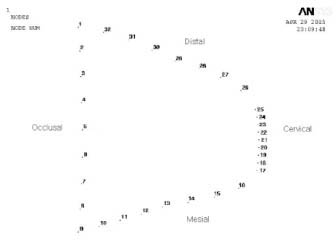References
1. Grippo JO, Simring M, Schreiner S. Attrition, abrasion, corrosion and abfraction revisited: A new perspective on tooth surface lesions. J Am Dent Assoc 2004. 135(8)1109–1118.
2. Gallien GS, Kaplan I, Owens BM. A review of noncarious dental cervical lesions. Compendium 1994. 15(11)1366–1374.
3. Owens BM, Gallien GS. Noncarious dental "abfraction" lesion in aging population. Compend Contin Educ Dent 1995. 16552–561.
4. Cho IS, Park JI, Kwon HC. The microleakage of light-cured glass lonomer restorative materials in class v cavities. J Korean Acad Conserv Dent 1998. 23(1)304–315.
5. Minakuchi S, Munoz CA, Jessop N. Effect of flexural load cycling on microleakge of extended root caries restorations. Oper Dent 2005. 30(2)234–238.
6. Yazici Ar, Celik C, Ozgunaltay G. Microleakage of different resin composite types. Quintessence Int 2004. 35(10)790–794.
7. Park JK, Hur B, Lee HJ. The effect of cavity configuration on marginal leakage of class 5 restoration. J Korean Acad Conserv Dent 2001. 26(2)162–170.
8. Jang HJ, Lee HJ, Hur B. Comparison of marginal leakage of wedge-shaped class v cavity according to restorative materials. J Korean Acad Conserv Dent 2000. 25(1)56–62.
9. Perdigao J, Lambrechts P, Van Meerbeek B, Braem M, Tildiz E, Yucel T, Vanherle G. The interaction of adhesive systems with human dentin. Am J Dent 1996. 9(4)167–173.
10. Braga RR, Cesar PF, Gonzaga CC. Tensile bond strength of filled and unfilled adhesives to dentin. Am J Dent 2000. 13(2)73–76.
11. Lee HE, Lin CL, Wang CH, Chen Ch, Chang CH. Stresses at the cervical lesion of maxillary premolar - a finite element investigation. J Dent 2002. 30(7-8)283–290.
12. Rees JS, Hammadeh M, Jagger DC. Abfraction lesion formation in maxillary incisors, canines and premolars: a finite element study. Eur J Oral Sci 2003. 111(2)149–154.
13. Son YH, Cho BH, Um CM. Finite element stress analysis of class v composite resin restoration subjected to cavity forms and placement methods. J Korean Acad Conserv Dent 2000. 25(1)91–108.
14. Litonjua LA, Bush PJ, Andreana S, Tobias TS, Cohen RE. Effects of occlusal load on cervical lesions. J Oral Rehabil 2004. 31(3)225–232.
15. Rees JS. The effect of variation in occlusal loading on the development of abfraction lesions: a finite element study. J Oral Rehabil 2002. 29(2)188–193.
16. Yaman SD, Sahin M, Aydin C. Finite element analysis of strength characteristics of various resin based restorative materials in Class V cavities. J Oral Rehabil 2003. 30(6)630–641.
17. Palamara D, Palamara JE, Tyas MJ, Messer HH. Strain patterns in cervical enamel of teeth subjected to occlusal loading. Dent Mater 2000. 16(6)412–419.
18. Fruits TJ, VanBrunt CL, Khajotia SS, Duncanson MG Jr. Effect of cyclical lateral forces on microleakage in cervical resin composite restorations. Quintessence Int 2002. 33(3)205–212.
19. Leinfelder KF. Restoration of abfracted lesions. Compendium 1994. 15(11)1396–1400.
20. Heymann HO, Sturdevant JR, Bayne S, Wilder AD, Sluder TB, Brunson WD. Examining tooth flexure effects on cervical restorations: a two-year clinical study. J Am Dent Assoc 1991. 122(5)41–47.
21. Kemp-Scholte CM, Davidson CL. Marginal integrity related to bond strength and strain capacity of composite resin restorative systems. J Prosthet Dent 1990. 64(6)658–664.
22. Bayne SC, Thompson JY, Swift EJ Jr, Stamatiades P, Wilkerson M. A characterization of first-generation flowable composite. J Am Dent Assoc 1998. 129(5)567–577.
23. Gomec Y, Dorter C, Dabanoglu A, Koray F. Effect of resin-based material combination on the compressive and the flexural strength. J Oral Rehabil 2005. 32(2)122–127.
24. Katona TR, Winkler MM. Stress analysis of a bulk-filled Class V light-cured composite resotration. J Dent Res 1994. 73(8)1470–1477.
25. Geramy A, Sharafoddin F. Abfraction: 3D analysis by means of the finite element method. Quintessence Int 2003. 34(7)526–533.
26. Rees JS, OIDougherty D, Pullin R. The stress reducing capacity of unfilled resin in a Class V cavity. J Oral Rehabil 1999. 26(5)422–427.
27. Kim IC. A Study of the Gnathodynamometer. Korean Med J 1963. 8(11)
28. Gibbs CH, Mahan PE, Lundeen HC, Brehnan K, Walsh EK, Sinkewiz SL, Ginsberg SB. Occlusal forces during chewing-Influences of biting strength and food consistency. J Prosthet Dent 1981. 46(5)561–567.
29. Cavel WT, Kelsey WP, Blankenau RJ. An in vivo study of cuspal fracture. J Prosthet Dent 1985. 53(1)38–42.
30. Yettram AL, Wright KW, Pickard HM. Finite element stress analysis of the crowns of normal and restored teeth. J Dent Res 1976. 55(6)1004–1011.
31. Rees JS. A review of the biomechanics of abfraction. Eur J Prosthodont Restor Dent 2000. 8(4)139–144.
32. Kuroe T, Itoh H, Caputo AA, Konuma M. Biomechanics of cervical tooth structure lesions and their restoration. Quintessence Int 2000. 31(4)267–274.
33. Rees JS, Hammadeh M. Undermining of enamel as a mechanism of abfraction lesion formation: a finite element study. Eur J Oral Sci 2004. 112(4)347–352.
34. Verdonschot N, Fennis WM, Kuijs RH, Stolk J, Kreulen CM, Creugers NH. Generation of 3-D finite element models of restored human teeth using micro-CT techniques. Int J Prosthodont 2001. 14(4)310–315.
35. Kuroe T, Caputo AA, Ohata N, Itoh H. Biomechanical effects of cervical lesions and restoration on periodontally compromised teeth. Quintessence Int 2001. 32(2)111–118.









